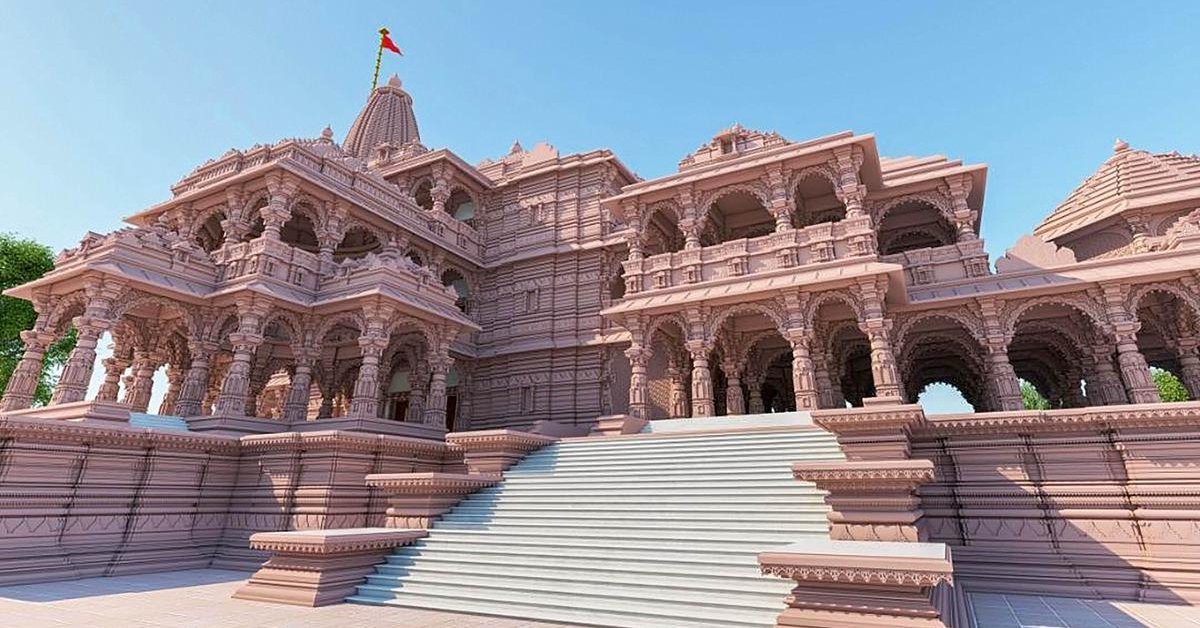In our detailed blog, explore the Ayodhya Ram Mandir’s rich history, stunning architecture, and profound cultural impact. Learn about its global significance and what the future holds.
Table of Contents
The Ayodhya Ram Mandir, a temple dedicated to Lord Rama, is being constructed in the city of Ayodhya in Uttar Pradesh, India.
This temple holds significant cultural, historical, and spiritual importance in Hinduism.
Facts About Ayodhya Ram Mandir
Here is an exhaustive look into ten facets of the Ayodhya Ram Mandir, each featuring ten interesting facts to enhance your understanding of this iconic structure.
Historical Background
- Ayodhya is considered the birthplace of Lord Rama, a principal figure in the ancient Indian epic, the Ramayana.
- The idea of building a temple at the disputed site has been a subject of contention and religious fervor for several centuries.
- Historical texts and oral traditions suggest a temple existed at the site before the Mughal era.
- The Babri Masjid stood at the site from 1528 until its demolition in 1992.
- Archaeological surveys have indicated the presence of pre-existing temple structures under the mosque.
- In November 2019, the Indian Supreme Court ruled in favor of constructing the Ram Mandir at the site.
- The court also allocated an alternative 5-acre site to the Sunni Waqf Board for building a mosque.
- The official groundbreaking ceremony for the Ram Mandir occurred on August 5, 2020.
- Prime Minister Narendra Modi and other dignitaries attended the event.
- The temple is expected to alter the socio-religious landscape of Ayodhya and its surroundings.
Design and Architecture
- The traditional Nagara style of Indian architecture inspires the temple design.
- The final plan includes a structure with five domes.
- The temple will stand 161 feet tall upon completion.
- The architectural plan incorporates elements from several historical temples across India.
- The complex will include visitor facilities, a museum, and a digital archive.
- The central sanctum will house the idol of Lord Rama, standing under a gilded dome.
- Eco-friendly materials and ancient construction techniques are being utilized.
- The site will also feature a theme park that narrates tales from the Ramayana.
- Sandstone from Rajasthan, known for its durability and beauty, is primarily used in construction.
- The design aims to accommodate over 50,000 devotees daily.
Cultural Significance
- The Ram Mandir is a symbol of cultural revival for Hindu traditions.
- It is anticipated to be a major pilgrimage site, drawing millions from around the globe.
- The temple symbolizes a long-standing desire to restore a Hindu cultural edifice at Ayodhya.
- Festivals like Ram Navami and Diwali are expected to see unprecedented gatherings at the temple.
- The temple will likely promote Ayodhya’s rich tapestry of performing arts, crafts, and rituals.
- It is seen as a beacon for communal harmony and spiritual reconciliation.
- The temple’s construction is perceived as fulfilling prophecies within several Hindu texts.
- Educational programs about Hindu scriptures and ethics are planned for visitors.
- The complex will include exhibits showcasing the archaeological and historical studies related to Ayodhya.
- It aims to enhance the socio-economic status of the local community through increased tourism.
Economic Impact
- The construction is expected to boost local employment and business opportunities.
- An influx of pilgrims is projected to benefit the hospitality and service sectors in Ayodhya significantly.
- The temple is anticipated to attract global donations and funding.
- Small and medium enterprises (SMEs) in the region will likely grow due to increased demand for products and services.
- The government plans infrastructure developments, including improved roads, better public transport, and enhanced facilities.
- Real estate values in and around Ayodhya are expected to rise.
- The project is seen as a driver for rural development in Uttar Pradesh.
- Artisans, craftsmen, and cultural performers will find new opportunities for patronage.
- Ayodhya could evolve into a major center for religious tourism and spiritual education.
- The temple might spark a traditional arts and crafts renaissance, reviving age-old skills.
Construction Details
- The Shri Ram Janmabhoomi Teerth Kshetra Trust is constructing the temple.
- The estimated full completion date is projected for 2026, though this may vary, and alongside 2024, the temple will be inaugurated.
- The foundation alone required extensive engineering to ensure stability and longevity.
- Innovative techniques are being used to protect the structure from natural disasters.
- The final construction will use over 10,000 cubic feet of pink sandstone.
- The site’s preparation involved one of the largest soil-testing programs in India.
- Modern technology and ancient Vedic building principles are blended in the construction process.
- The project has seen contributions from various sectors, including private donations and government funding.
- Much manual craftsmanship goes into the carving and construction of temple details.
- Security measures are being extensively planned to ensure the site’s and its visitors’ safety.
Legal Aspects
- The Supreme Court’s 2019 verdict was pivotal in allowing the temple construction to proceed.
- The verdict ended decades of litigation involving multiple parties with conflicting claims.
- Legal provisions have been made to protect and sanctify the site for exclusive religious use.
- The temple trust is regulated under specific guidelines to maintain transparency and accountability.
- Measures are in place to ensure the ongoing legal protection of the site against potential disputes.
- Intellectual property related to the temple’s design and artifacts is carefully guarded.
- The government has enacted several laws to facilitate the smooth execution of the project.
- Legal experts continue to monitor the developments to preempt any possible legal challenges.
- The allocation of nearby land for the mosque was also part of the legal settlement.
- The temple’s construction is often cited as a case study in India’s religious and civil law courses.
Technological Innovations
- Advanced engineering techniques are employed to ensure the structural integrity of the temple.
- Eco-friendly technologies are integrated to minimize environmental impact.
- The project uses state-of-the-art water recycling and waste management systems.
- Solar power is planned to be a primary energy source for the temple complex.
- The temple will feature interactive displays and augmented reality experiences for education on Hindu scriptures.
- High-tech security systems, including surveillance and crowd management technologies, are being installed.
- Computer-aided design (CAD) has been crucial in planning and visualizing complex structures.
- Robotic tools are used for precision work in carving and construction.
- The temple complex will include a high-speed digital communication network for operations and safety.
- Innovative lighting techniques will enhance the aesthetic appeal and highlight architectural features.
Community Involvement
- Local communities are deeply involved in the temple’s construction, providing labor and materials.
- Cultural and spiritual programs organized by the temple are open to all, fostering a sense of community.
- The project has united people from various walks of life to support a common cause.
- Community leaders are actively engaged in decision-making processes regarding the temple’s activities.
- Regular updates and transparent communication with the public have been a priority for the trust.
- The temple initiative includes community development programs such as education and healthcare.
- Local artisans and craftsmen receive support and training to contribute to the temple construction.
- Volunteering opportunities at the site and for the trust’s activities have seen wide participation.
- The temple has become a focal point for communal harmony initiatives.
- Special programs are designed to include marginalized sections of the community in the benefits accruing from the temple.
Global Impact
- The temple has received attention and support from the Indian diaspora worldwide.
- It is involved in global Hindu community events, promoting cultural exchange.
- International media coverage has increased Ayodhya’s global visibility.
- The temple is part of discussions on religious architecture in global forums.
- It serves as a model for international cooperation in heritage and cultural preservation.
- Global scholars and historians keenly observe the temple’s development.
- The project receives academic interest for its blend of tradition and modernity.
- International tourists are expected to contribute to the temple’s visitor demographics.
- The temple has sparked interest in Indian spiritual and cultural tourism.
- It promotes global peace and understanding through its underlying message of unity and heritage.
Future Prospects
- Plans are in place to expand the temple complex with more facilities for visitors and pilgrims.
- The temple is expected to be key in promoting regional stability and prosperity.
- Educational institutions and research centers might be established to study Hindu scriptures and philosophy.
- The temple could influence the architectural styles of future religious and cultural structures in India.
- Ongoing archaeological studies around Ayodhya might unearth more insights into ancient Indian history.
- The temple is poised to become a center for major Hindu festivals and cultural events.
- It might inspire similar projects in other parts of India and worldwide.
- The trust plans to engage in more community service initiatives for its broader mission.
- Focusing on sustainable tourism will likely be a priority in the coming years.
- The temple’s completion is anticipated to mark a new chapter in the cultural renaissance of India.
Conclusion
This comprehensive guide to the Ayodhya Ram Mandir illuminates its multifaceted nature and emphasizes its significance in various spheres, from religious and cultural to economic and legal.
As the temple progresses toward completion, it symbolizes heritage and unity, promising to shape India’s cultural and spiritual landscape for future generations.






